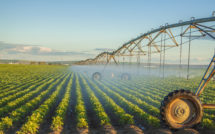
A Legal Foundation: Critical to a Realized SDG 6 and Universal Access to Water and Sanitation

This is part of our special feature on Water in Europe and the World.
It seems simple: water and sanitation are essential to life and livelihood, and thus everyone should have access to these basic necessities and services. But therein lays the challenge. They are services that demand resources, capacity, infrastructure, and governance to be safely and efficiently delivered. Services do not come free. And the reality is: it costs a lot to provide water and sanitation services, it is not easy to provide these services, and everyone should but not everyone can pay. By the same token, water and sanitation services are basic necessities. Access to these basic necessities underpin a healthy community and vibrant economy. This tension raises two essential questions: (a) what is the responsibility of the government or the utility when providing something that is both a fundamental need and a service that demands resources, and (b) how does the law govern the complicated provision of both a service and a necessity? The second question is what we will explore here.
Perhaps our most important finding is that there is limited data and information available on the scope of water access and affordability challenges. We know how many people across the world do not have access to improved drinking water and safely managed sanitation. However, there are households who face a persistent threat of losing access to drinking water and sanitation and wind up losing access for failure to pay, but we do not know how many. This is the accessibility trap. Once a family has access to drinking water and sanitation services, there is often no guarantee that they will retain that access. Without laws that balance the service-necessity catch-22, gaining access to drinking water and sanitation could be fleeting.
Laws play a critical role in determining long-term access to water and sanitation services. Laws—including legislation, regulations, policies, plans, and strategies drafted by legislatures, ministries, regulators and utilities—set forth standards of service and rules governing the provision of service. There are a variety of ways in which the laws can acknowledge or ignore the accessibility trap. For example, the law can allow for water shutoffs without providing alternative payment timelines or rate assistance, thereby punishing those who cannot pay and those that chose not to pay in the same way. Water shutoffs in isolation frustrate the accessibility trap. Water shutoffs complemented with rate assistance do not. Because providing treated drinking water is a service, there is an expectation and a need for payment. Service providers do not just pipe out river water; they treat water to meet contaminant levels that guarantee the water is safe for human consumption. Because it is a service, shutoffs seem like a reasonable reaction for a failure to pay. However, drinking water and sanitation services are more than just services—they are governmental priorities often attached to goals of universal access, where terminating service because someone cannot pay seems ultimately counterintuitive. Hence, when water shutoff laws are complemented with rate assistance programs or payment programs, they stop being a blunt instrument and better balance the service-necessity catch-22.
In other circumstances, the law takes a clear position on the service-necessity catch-22 without endangering either. The Constitution can provide for a right to water and sanitation that entails access to basic services, any use beyond which the recipient must pay for. This responds to the service-necessity catch-22 by requiring the state to provide universal access to drinking water and sanitation, limited to providing basic services, despite ability or inability to pay.[1]
Laws are at the front line of guaranteeing universal access to water and sanitation services. Despite that fact, few studies have been conducted to understand the role of existing laws in facilitating or impeding accessibility. Laws provide a varying degree of support for advancing access to these services. The variation across countries and across jurisdictions within one country demonstrates the wide range of approaches that can be taken and, ultimately, the inequalities that can result.
The Sustainable Development Goals (SDGs), adopted in 2015, raised the bar for water and sanitation service provision. The predecessor to the SDGs—the Millennium Development Goals (MDGs) —set a goal of halving the proportion of the population without sustainable access to safe drinking water and basic sanitation by 2015. The SDGs, which came into effect in 2016, not only increased the expected coverage but added a quality of service component. SDG 6 set a target of achieving universal and equitable access to safe and affordable drinking water as well as adequate and equitable sanitation for all by 2030. The goal prioritizes guaranteeing access to drinking water and sanitation services, irrespective of ability to pay, and expects that that service be of an equitable and safe quality. While the SDGs are not enforceable, their adoption by the United Nations has prompted worldwide conversation about the steps necessary to achieving universal access. In some jurisdictions this has led to revised laws and policies while in other jurisdictions existing laws already represent an innovative approach to accessibility or have remained unchanged.
The European Union Drinking Water Directive has been revised to require member states to focus on accessibility.[2] Prompted by a European Citizens’ Initiative (ECI), Article 13 entitled “Access to water intended for human consumption” has been added to require that Member States “take all necessary measures to improve access for all to water intended for human consumption and promote its use on their territory.”[3] As described in the Explanatory Memorandum, Article 13 lays out two new objectives: one to expand access, particularly to vulnerable and marginalized communities, and a second to encourage the use of tap water. It is interesting that the E.U. has taken such a broad view of access. By also promoting an expanded use of tap water Member States can expand the ratepayer base which increases the revenue available to rehabilitate infrastructure and to offer rate assistance programs that can reduce the use of water shutoffs to extract pay from households unable to pay. This builds on the EU Water Framework Directive which requires that recovery of costs for providing water and sanitation services. Article 9 states, “Member States shall take account of the principle of recovery of the costs of water services, including environmental and resource costs, having regard to the economic analysis conducted according to Annex III, and in accordance in particular with the polluter pays principle…Member States may in so doing have regard to the social, environmental and economic effects of the recovery as well as the geographic and climatic conditions of the region or regions affected.” By integrating this principle into the Directive, there is an expectation that service providers fully recuperate the costs associated with providing water and sanitation services, preventing undercharging. However, this does not preclude the development of alternative rate structures for vulnerable or marginalized communities. The revised Drinking Water Directive further develops upon this prioritization of accessibility and creates a legal foundation and expectation for actualizing universal access to sanitation and water services.
In Spain, the Ley de Aguas did not expand guarantees to access water and sanitation beyond the protections provided in the Water Framework Directive. Article 111bis. almost verbatim adopts the language set forth in Article 9 of the Water Framework Directive. But one key addition seems to focus this provision more on the environmental benefits derived from full-cost recovery that is not seen in the Water Framework Directive. At subsection (3) the law states that the social, environmental, and economic effects of the recovery can be taken into consideration as long as they do not compromise the achievement of the identified environmental objectives.[4] Whereas this provision in the WFD seems to raise the import of accessibility in cost recovery, the caveat included in the Spanish law seems to cut against that. The Spanish law ultimately prioritizes the achievement of environmental objectives over any accounting for social and economic effects.
While the national-level Ley de Aguas does not address accessibility, the Ley de Aguas of many of the autonomous communities do. Ley 12/2002 of 27 June entitled “Reguladora del Ciclo Integral del Agua” for the Autonomous Community Castilla-La Mancha sets out as an objective the “[g]uarantee of water supply in adequate quantity and quality, in all the municipalities of Castilla-La Mancha.”[5] At Article 19 the law states that under normal conditions the supply to be provided to each citizen should not be less than 100 liters per day.[6] However, the law falls short of creating a right to this amount and only states that the amount to be made available to each citizen through the public water system should not fall short of 100 liters per day. Sixteen years later, the Autonomous Community of Andalucia has amended its Ley de Aguas to recognize a human right to water.[7] The law provides minimal detail on what is required to actualize the right, acknowledging that the right will be further developed through regulations. However, it does state that the human right to water is envisioned as a volume of water sufficient to meet basic needs, including sanitation.[8] This is an important addition because most existing infrastructure provides for flush toilets (rather than non-sewered sanitation) and uses drinking water for toilet flushing. If these additional needs were not recognized, they could be counted against the drinking water needs of a household, critically decreasing the water available for drinking and other domestic purposes. Acknowledging a human right to water and sanitation can be an important step toward achieving universal access; however, it is the details that make that right actionable.
South Africa took a drastic step to increasing accessibility to water and sanitation services by adopting the Water Services Act in 1997, one year before the adoption of the National Water Act. The 1996 South African Constitution declares that everyone “has the right to have access to…sufficient food and water.”[9] The 1997 Water Services Act (WSA) further crystalizes this right by stating that “[e]veryone has a right of access to basic water supply and basic sanitation” and requiring that water service authorities develop measures that will actualize the newly created rights.[10] Basic water supply and basic sanitation are also defined in the law, providing a clear scope of what kind of sanitation and water supply services are covered within each right: “(ii) “basic sanitation” means the prescribed minimum standard of services necessary for the safe, hygienic and adequate collection, removal, disposal or purification of human excreta, domestic waste-water and sewage from households, including informal households; (iii) “basic water supply” means the prescribed minimum standard of water supply services necessary for the reliable supply of a sufficient quantity and quality of water to households, including informal households, to support life and personal hygiene.”[11] Regulations in 2001 further clarified what is expected in providing these basic services. Under these regulations the minimum standard for basic water supply is “a minimum quantity of potable water of 25 litres per person per day or 6 kilolitres per household per month— (i) at a minimum flow rate of not less than 10 litres per minute; (ii) within 200 metres of a household; and (iii) with an effectiveness such that no consumer is without a supply for more than seven full days in any year.”[12] Not only do the regulations set a minimum quantity that is expected to be available to all person, but also a quality of service including that the water must be within a certain distance of their home and be provided reliably 358 days out of the year. While South Africa has made great strides legislatively to advance universal access, the United States has far to go to guarantee widespread equitable access to safe and reliable water and sanitation services.
Within the United States, the Federal government plays a limited role in the provision of drinking water and sanitation services. The Safe Drinking Water Act (SDWA) identifies regulated contaminants and establishes standards for those regulated contaminated that must be met at the tap.[13] The Federal Water Pollution Control Act (FWPCA), best known as the Clean Water Act (CWA), governs the discharges of wastewater into waters of the United States and requires certain effluent and water quality standards to be met by wastewater treatment plants.[14] The laws governing the provision of drinking water and sanitation exist primarily at the county and municipal level, with limited state involvement.
Only three States have recognized a right to water: California, Massachusetts, and Pennsylvania, but with little impact to other service-related laws that can diminish accessibility to services.[15] Recognizing a human right does not guarantee access to water. Across the United States, local-level laws allow for water services to be shutoff for nonpayment of water and sewer bills in spite of offering no rate assistance programs to low-income households. In Maryland, the majority of municipalities have the authority to shutoff water services for nonpayment but do not offer rate assistance to households unable to pay for water services.[16] In addition to being exposed to shutoffs, low-income households whose bills go unpaid can have a lien placed on their house and be foreclosed upon. Furthermore, often times the money collected from ratepayers is not ring-fenced for water services, but rather is placed in a general fund. In California, Proposition 218 forbids creating a rate structure that is not directly tied to the costs of providing the services. With this restriction, higher income households cannot be charged more, limiting the options available to lower the cost for low-income families. The laws play an essential role in determining whether and to whom water is accessible and the financial security of water infrastructure and the United States have far to go.
The laws and policies governing rate setting and accessibility must be compatible in order for these essential services to be universally accessible, but not at the expense of safe and reliable infrastructure. Rate setting, accessibility and affordability of water and sanitation services are all inextricably linked. The examples provided illustrate the variety of approaches taken to use the law to foster accessibility and sustainable rate-setting. Some laws focus more on cost recovery than accessibility, while others focus on declaring and actualizing a human right to water. While the approaches may be different, the law is essential to prioritizing universal access to water and sanitation and to creating actionable rights. Without a strong legal foundation, any realization of SDG 6 will remain elusive.
Alexandra Campbell-Ferrari is the Co-Founder and Executive Director of The Center for Water Security and Cooperation, a 501(c)(3) nonprofit organization based in Washington D.C. dedicated to advancing water security by understanding, evaluating, and innovating in water law and governance. Alexandra also teaches water law at the University of Maryland Carey School of Law and American University Washington College of Law. Before co-founding The CWSC she was a Fulbright Scholar in Spain researching water law and watershed management in Spain and the European Union. Alexandra is also on the Board of Directors for the Bucknell University Alumni Association and the Advisory Board for the Bucknell Institute for Public Policy.
Luke Wilson is the Co-Founder and Deputy Director of The Center for Water Security and Cooperation. Prior to co-founding The CWSC, Luke was an attorney in a boutique solo practice providing advice to international lawyers, diplomats and arbitrators on matters of international law. Luke also previously served as a law clerk to judges of the International Court of Justice, where he worked on interstate disputes over water and other public international law issues. In addition to his work with The CWSC, Luke teaches International Law at The George Washington University Elliot School of International Affairs. Luke is also a tenor in the Washington Chorus.
References:
[1] While a Constitution may recognize a right to drinking water and/or sanitation, such a declaration leaves much open for debate, including what standard of service must be provided to realize the right, how much access is needed to actualize the right (i.e. how much water is a person owed per day), and whether a “right” to such services requires the services to be free.
[2] On 23 October 2018, the European Parliament adopted by 300 votes to 98, amendments to the proposed Directive. Procedure file 2017/0332 (COD), available at https://oeilm.secure.europarl.europa.eu/oeil-mobile/fiche-procedure/2017/0332(COD). The amendments adopted by the European Parliament can be found at http://www.europarl.europa.eu/sides/getDoc.do?type=TA&language=EN&reference=P8-TA-2018-0397.
[3] Directive of the European Parliament and of the Council on the quality of water intended for human consumption (recast), 2017/0332(COD) (the recast Directive proposal of Directive 98/83/EC).
[4] Ley de Aguas, “3.Para la aplicación del principio de recuperación de costes se tendrán en cuenta las consecuencias sociales, ambientales y económicas, así como las condiciones geográficas y climáticas de cada territorio y de las poblaciones afectadas siempre y cuando ello no comprometa los fines ni el logro de los objetivos ambientales establecidos” (emphasis added).
[5] Ley 12/2002 de 27 de junio, Artículo 4.1 (stating “[g]arantía de suministro de agua en cantidad y calidad adecuadas, en todos los municipios de Castilla-La Mancha.”).
[6] Ley 12/2002 de 27 de junio, Artículo 19.1 (stating “La dotación, en condiciones de normalidad, no deberá ser inferior a cien litros por habitante y día.”).
[7] Ley 9/2010, de 30 de julio, de Aguas de Andalucía at Disposición adicional decimosexta (this law was recently amended and disposición adicional decimosexta was included as a result of Ley 8/2018, de 8 de octubre, de medidas frente al cambio climático y para la transición hacia un nuevo modelo energético en Andalucía, BOE-A-2018-15238). Disposición adicional decimosexta will go into effect 15 January 2019.
[8] Id (starting “un volumen de agua apta para el consumo humano para atender las necesidades básicas, así como al saneamiento.”
[9] Constitution of the Republic of South Africa, Act 108 of 1996 available at http://www.justice.gov.za/legislation/constitution/SAConstitution-web-eng.pdf.
[10] Water Services Act, Act No. 108, Article Article 2 (19 December 1997) at Article 3 (stating “(1) Everyone has a right of access to basic water supply and basic sanitation. (2) Every water services institution must take reasonable measures to realise these rights. (3) Every water services authority must, in its water services development plan provide for measures to realise these rights. (4) The rights mentioned in this section are subject to the limitations contained in this Act.”).
[11] Id at Article 1.
[12] Regulations Relating to Compulsory National Standards and Measures to Conserve Water, No. R. 509, 8 June 2001, Article 3.
[13] Safe Drinking Water Act, 42 U.S.C. §300f et seq. (1974).
[14] Clean Water Act, 33 U.S.C. §1251 et seq. (1972).
[15] The Constitutions of Massachusetts and Pennsylvania recognize a right to clean or pure water while the law of California creates a “right to safe, clean, affordable, and accessible water adequate for human consumption, cooking, and sanitary purposes.” Constitution of the Commonwealth of Massachusetts, art. XCVII; Constitution of the Commonwealth of Pennsylvania, Art. 1, Sec. 27; Cal Wat Code § 106.3 (2016). The California Utility code also states that an adequate supply of water “shall be made available to all residents of California at an affordable cost.” Cal Pub Util Code § 739.8 (2016).
[16] Forthcoming, Water Affordability: An examination of county and municipal laws impacting the affordability of water and sewer services in Maryland, U.S.A., The Center for Water Security and Cooperation, December 2018.
Photo: Close-up of a bright classical pillar | Shutterstock
Published on December 11, 2018.




